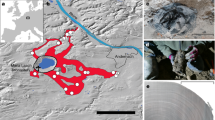Abstract
Results of high-resolution AMS 14C dating of terrestrial plant macrofossils from late-glacial and early-Holocene lake deposits in Switzerland show three periods with constant radiocarbon ages. These plateaux of constant age occur at 12700, 10000, and 9500 y BP. A comparison of this radiocarbon chronology with a varve chronology documents discrepancies between the sidereal and the radiocarbon time-scale for the late-glacial period. The age-plateaux and the time-scale discrepancies have a significant impact on the estimation of rates of change during this period: estimates of rates of change can be very misleading if calculated on the basis of radiocarbon ages. This is illustrated by an example of estimated rates of late-glacial and early Holocene palynological change in Switzerland.
Similar content being viewed by others
References
Ammann B (1989a) Late-Quaternary palynology at Lobsigensee. Regional vegetation history and local lake development. Diss Bot 137:1–157
Ammann B (1989b) Periods of rapid environmental change around 12500 and 10000 years BP, as recorded in Swiss lake deposits. J Paleolimnol 1:269–277
Ammann B, Lotter AF (1989) Late-Glacial radiocarbon- and palynostratigraphy on the Swiss Plateau. Boreas 18:109–126
Andrée M, Oeschger H, Siegenthaler U, Riesen T, Moell M, Ammann B, Tobolski K (1986) 14C dating of plant macrofossils in lake sediment. Radiocarbon 28/2:411–416
Becker B, Kromer B (1986) Extension of the Holocene dendrochronology by Preboreal pine series, 8800 to 10000 BP. Radiocarbon 28/2B:961–967
Becker B, Kromer B (1990) Dendrochronology and radiocarbon calibration of the early Holocene. In: Barton N, Roe D & Roberts A (eds) The late glacial of NW Europe. Oxford (in press)
Björck S, Berglund BE, Digerfeldt G (1988) New aspects of the deglaciation chronology of South Sweden. Geogr Polonica 55:47–49
Elias SA, Wilkinson B (1983) Lateglacial insect fossil assemblages from Lobsigensee (Swiss Plateau). Rev Paléobiol 2:189–204
Elias SA, Wilkinson B (1985) Fossil assemblages of Coleoptera and Trichoptera at Lobsigensee. In: Lang G (ed) Swiss lake and mire environments during the last 15000 years. Diss Bot 87:157–182
Firbas F (1949) Spät- und nacheiszeitliche Waldgeschichte Mitteleuropas nördlich der Alpen. Fischer, Jena. 480 pp
Firbas F (1954) Die Synchronisierung der mitteleuropaischen Pollendiagramme. Damn Geol Unders 11/80:12–21
Hofmann W (1983) Stratigraphy of subfossil Chironomidae and Ceratopogonidae (Insecta: Diptera) in lateglacial littoral sediments from Lobsigensee (Swiss Plateau). Rev Paléobiol 2:205–209
Hofmann W (1985a) Developmental history of Lobsigensee: subfossil Cladocera (Crustacea). In: Lang G (ed) Swiss lake and mire environments during the last 15000 years. Diss Bot 87:150–153
Hofmann W (1985b) Developmental history of Lobsigensee: subfossil Chironomidae (Diptera). In: Lang G (ed) Swiss lake and mire environments during the last 15 000 years. Diss Bot 87:154–156
Huntley B (1990) Dissimilarity mapping between fossil and contemporary pollen spectra in Europe for the past 13 000 years. Quat Res 33:360–376
Jacobson GL, Grimm EC (1986) A numerical analysis of Holocene forest and prairie vegetation in central Minnesota. Ecology 67:958–966
Jacobson GL, Webb T, Grimm EC (1987) Patterns and rates of vegetation change during the deglaciation of eastern North America. In: Ruddiman WF and Wright HE (eds) North America and adjacent oceans during the last deglaciation The Geology of North America Vol K-3. Geological Society of America. Boulder Colorado. 277–288
Küttel M (1979) Pollenanalytische Untersuchungen zur Vegetationsgeschichte und zum Gletscherrückzug in den westlichen Schweizer Alpen. Berichte Schweizerische Botanische Gesellschaft 89:9–62
Lang G, Tobolski K (1985) Hobschensee — late-glacial and Holocene environment of a lake near the timberline. In: Lang G (ed) Swiss lake and mire environments during the last 15 000 years. Diss Bot 87:209–228
Lotter A (1988) Paläoökologische und paläolimnologische Studie des Rotsees bei Luzern. Pollen-, grossrest-, diatomeen- und sedimentanalytische Untersuchungen. Diss Bot 124:1–187
Lotter AF (1989) Evidence of annual layering in Holocene sediments of Soppensee, Switzerland. Aq Sci 51:19–30
Lotter AF (1991a) How long was the Younger Dryas? Preliminary evidence from annually laminated sediments of Soppensee (Switzerland). Hydrobiol 214:53–57
Lotter AF (1991b) Absolute dating of the late-glacial period in Switzerland using annually laminated sediments. Quat Res 35:321–330
Lotter AF, Zbinden H (1989) Late-Glacial palynology, oxygen isotope record, and radiocarbon stratigraphy from Rotsee (Lucerne), central Swiss Plateau. Eclogae geol Helv 82:191–202
Mangerud J, Andersen ST, Berglund BE, Donner J (1974) Quaternary stratigraphy of Norden, a proposal for terminology and classification. Boreas 3:109–128
Oberdorfer E (1937) Zur spat- und nacheiszeitlichen Vegetationsgeschichte des Oberelsasses und der Vogesen. Z Botanik 30:513–557
Overpeck JT, Webb T, Prentice IC (1985) Quantitative interpretation of fossil pollen spectra: dissimilarity coefficients and the method of modern analogs. Quat Res 23:87–108
Prentice IC (1980) Multidimensional scaling as a research tool in Quaternary palynology: a review of theory and methods. Rev Palaeobot Palynol 31:71–104
Stuiver M, Polach HA (1977) Reporting of 14C-data. Radiocarbon 19:355–363
Troels-Smith J (1955) Characterization of unconsolidated sediments. Damn Geol Unders IV, 3, 10:38–73
Welten M (1982) Vegetationsgeschichtliche Untersuchungen in den westlichen Schweizer Alpen: Bern-Wallis. Denkschr Schweiz Naturf Ges 95:1–104
Zbinden H, Andrée M, Oeschger H, Ammann B, Lotter A, Bonani G, Wölfli W (1989) Atmospheric radiocarbon at the end of the last glacial: an estimate based on AMS radiocarbon dates on terrestrial macrofossils from lake sediments. Radiocarbon 31:785–804
Zoller H (1987) Zur Geschichte der Vegetation im Spätglazial und Holozän der Schweiz. Mitt Naturf Ges Luzern 29:123–149
Author information
Authors and Affiliations
Additional information
Contribution to Clima Locarno — Past and Present Climate Dynamics; Conference September 1990, Swiss Academy of Sciences — National Climate Program
Rights and permissions
About this article
Cite this article
Lotter, A.F., Ammann, B. & Sturm, M. Rates of change and chronological problems during the late-glacial period. Climate Dynamics 6, 233–239 (1992). https://doi.org/10.1007/BF00193536
Received:
Accepted:
Issue Date:
DOI: https://doi.org/10.1007/BF00193536




